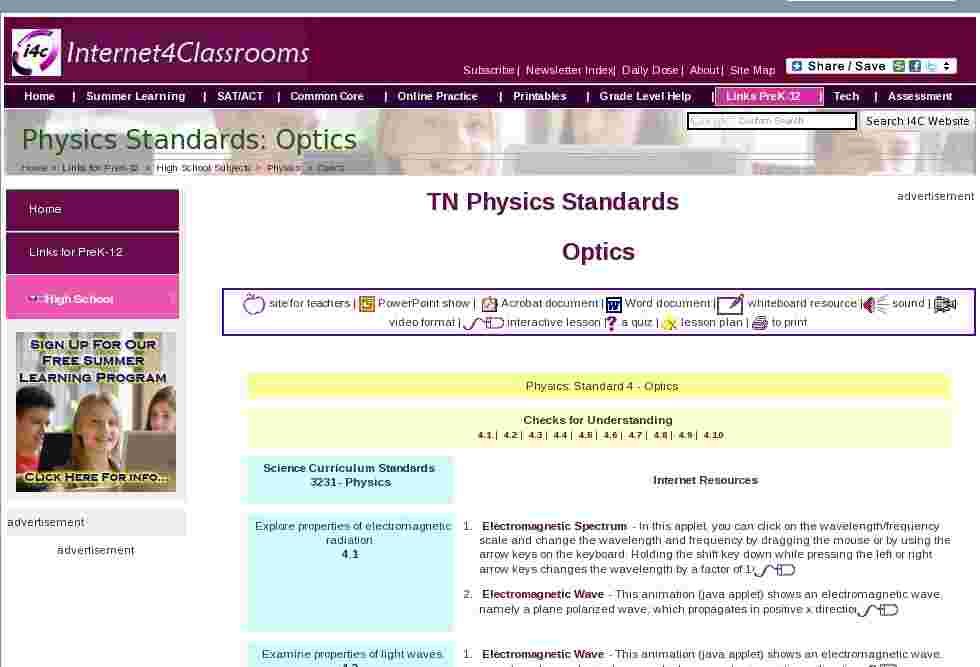TN Physics Standards
Optics
site for teachers |
PowerPoint show |
Acrobat document |
Word document |
whiteboard resource |
sound |
video format |
interactive lesson |
a quiz |
lesson plan |
to print
Science Curriculum Standards
3231 - Physics
- Electromagnetic Spectrum - In this applet, you can click on the wavelength/frequency scale and change the wavelength and frequency by dragging the mouse or by using the arrow keys on the keyboard. Holding the shift key down while pressing the left or right arrow keys changes the wavelength by a factor of 10.
- Electromagnetic Wave - This animation (java applet) shows an electromagnetic wave, namely a plane polarized wave, which propagates in positive x direction.
- Electromagnetic Wave - This animation (java applet) shows an electromagnetic wave, namely a plane polarized wave, which propagates in positive x direction.
- A set of Polarization lessons accompanied by interactive applets
- Building the impossible kaleidoscope - create colors by rotating the plane of polarization (scroll down, you did arrive at the right page)
- An index of ray optics animations from the Physics Classroom
- Ray Diagrams - Concave Mirrors
- Ray Diagrams - Convex Mirrors
- An index of ray optics animations from the Physics Classroom
- Ray Diagram Simulator - change variables - double convex lens

- The anatomy of a lens
- Refraction by Lenses
- Image Formation Revisited
- Ray Diagrams (converging lenses)
- Object-Image Relations
- Ray Diagrams (diverging lenses)
- Object-Image Relations
- The Mathematics of Lenses
- Thick Lens java applet which allows your students to manipulate the variables
- The transmission of a wave through dense media - Reflection and Refraction (an excellent java applet which allows your students to manipulate the variables
- An index of ray optics animations from the Physics Classroom
- Ray Diagrams - Concave Mirrors
- Ray Diagrams - Convex Mirrors
- Ray Diagram Simulator - change variables - double convex lens

- The anatomy of a lens
- Refraction by Lenses
- Image Formation Revisited
- Ray Diagrams (converging lenses)
- Object-Image Relations
- Ray Diagrams (diverging lenses)
- Object-Image Relations
- The Mathematics of Lenses
- Thick Lens java applet which allows your students to manipulate the variables
- The transmission of a wave through dense media - Reflection and Refraction (an excellent java applet which allows your students to manipulate the variables
- A set of Polarization lessons accompanied by interactive applets
- Make a permanent rainbow - Study thin film interference by making this "permanent rainbow." There is a good color calculator at the bottom of this page. (scroll down, you did arrive at the right page)
- Building the impossible kaleidoscope - create colors by rotating the plane of polarization (scroll down, you did arrive at the right page)
- Building a simple spectroscope (scroll down, you did arrive at the right page)
- The mathematics of refraction - Snell's law
- Boundary Behavior - the concepts behind the math known as Snell's law
- Snell's law Java applet from Northwestern University - manipulate the variables on both sides of the boundary, and see a wave front view or a laser view
- Refraction and Reflection - change the indices of refraction of the two media, and drag the incoming ray to any angle between 0 and 90 degrees
- Beat Frequencies in Sound - A beat frequency or beat wave is a sound of fluctuating volume caused when you add two sound waves of slightly different frequencies.

- Beats - a java applet to investigate this sound phenomenon
- Boundary Behavior - the concepts behind the math known as Snell's law
- Diffraction of Light by a Single Slit - an applet to investigate diffraction
- Hearing Subtraction - an activity on beats and frequency

- Index of wave terms - good diagrams accompany each definition
- The mathematics of refraction - Snell's law
- Refraction and Reflection - change the indices of refraction of the two media, and drag the incoming ray to any angle between 0 and 90 degrees
- Standing Wave - Explanation by Superposition with the Reflected Wave
- Snell's law Java applet from Northwestern University - manipulate the variables on both sides of the boundary, and see a wave front view or a laser view
- Electromagnetic and visible spectra
- Light absorption, reflection, and transmission - this tutorial includes practice questions
- Form white light by adding three colors of light using a click and drag applet
- Color addition - two questions to check understanding conclude this tutorial
- Color subtraction - examples are followed by a series of questions to check understanding
- Blue skies and red sunsets
- Mix light beams or paint pigments with this java applet (double right click to switch from light to paint)
- Shadows from overlapping colored light - This java applet let you play with shadow and image. To make it more fun, there are 3 different colors (Red/Green/Blue) light source.

Search Internet4Classrooms
 Custom Search
Custom Search
- Site Map |
- About Us |
- Teacher Training |
- Make Internet4Classrooms.com your home page. |
- Copyright © 2000-2024 Internet4Classrooms, LLC All rights reserved.
Use of this Web site constitutes acceptance of our Terms of Service and Privacy Policy.
1744510355469326 US 1 desktop not tablet not iPad device-width